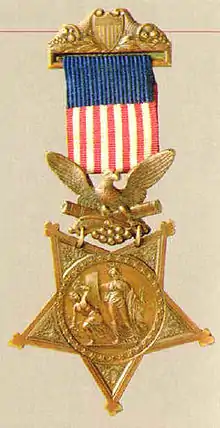Decatur Dorsey
Decatur Dorsey (1836 – July 11, 1891) was a Union Army soldier in the American Civil War and a recipient of the U.S. military's highest decoration, the Medal of Honor, for his actions at the Battle of the Crater. Born into slavery, Dorsey enlisted in the United States Colored Troops and served through the last year of the war.
Decatur Dorsey | |
|---|---|
 Medal of Honor, 1862-1895 Army version | |
| Born | 1836 Howard County, Maryland |
| Died | July 11, 1891 (aged 54–55) Hoboken, New Jersey |
| Place of burial | Flower Hill Cemetery, North Bergen, New Jersey |
| Allegiance | United States of America Union |
| Service/ | United States Army Union Army |
| Years of service | 1864–65 |
| Rank | First Sergeant |
| Unit | 39th United States Colored Infantry |
| Battles/wars | American Civil War • Battle of the Crater |
| Awards | Medal of Honor |
Biography
Dorsey was born a slave in 1836 in The Howard district of Anne Arundel County, Maryland, now Howard County. The Dorsey family held many large tobacco plantations in the region with many of their slave laborers taking on the name Dorsey. Decatur worked as a laborer at a time when the Enrollment Act allowed slaves to go in their place.[1] Accounts differ and list him as an escaped slave, and freeman when he enlisted in the Union Army from Baltimore on March 22, 1864, at the age of 25. He joined Company B of the 39th United States Colored Infantry as a private, but was promoted to corporal less than two months later, on May 17.[2]
On July 30, 1864, Dorsey took part in the Battle of the Crater in Petersburg, Virginia. With the Siege of Petersburg at a stalemate, Union forces hoped to break the city's defenses by detonating explosives in a tunnel dug beneath the Confederate lines and charging the enemy positions in the aftermath of the explosion. The blast blew a huge crater in the Confederate defenses, and white Union soldiers rushed in to attack. Men who entered the crater became trapped as the Confederates regrouped and began firing down at them.[2]
Dorsey's division, which had been held in reserve, was then ordered to reinforce the attack. Dorsey, serving as the 39th Regiment's color bearer, moved ahead of his unit during the advance and planted the flag on the Confederate fortifications. When the regiment was forced to pull back, he retrieved the flag and rallied his fellow soldiers for a second attack. In this second assault, the men of the 39th breached the Confederate works and engaged in hand-to-hand combat with the defenders. They captured two hundred prisoners and two flags before being pushed back again and ordered to withdraw.[2]
Dorsey was promoted to sergeant on August 1, two days after the battle, and again to first sergeant on January 1, 1865.[2] He was awarded the Medal of Honor on November 8, 1865,[3] for his actions at the Battle of the Crater and was discharged from the Army a month later, on December 4, while in Wilmington, North Carolina. After the war he married and lived in Hoboken, New Jersey.[2] He died there on July 11, 1891, at the approximate age of 55. He was buried at Flower Hill Cemetery in North Bergen, New Jersey.[2]
Medal of Honor citation
Planted his colors on the Confederate works in advance of his regiment, and when the regiment was driven back to the Union works he carried the colors there and bravely rallied the men.[3]
See also
References
 This article incorporates public domain material from websites or documents of the United States Army Center of Military History.
This article incorporates public domain material from websites or documents of the United States Army Center of Military History.
- Michael Hait. The Civil War Draft in Maryland - Lists of Drafted Men.
- Hanna, pp. 29–30.
- "Civil War Medal of Honor recipients (A–L)". Medal of Honor citations. United States Army Center of Military History. January 27, 2009. Retrieved February 10, 2009.
- Hanna, Charles W. (2002). African American recipients of the Medal of Honor: a biographical dictionary, Civil War through Vietnam War. Jefferson, North Carolina: McFarland & Company, Inc., Publishers. pp. 29–30. ISBN 0-7864-1355-7.
External links
- "Home of Heroes: Decatur Dorsey". Retrieved September 24, 2010.